Comprehensive Care for a Wide Range of Conditions
At Straight Up Chiropractic, our mission is to provide effective relief and lasting solutions for a variety of conditions that affect your daily life. From chronic pain and injuries to specific health concerns, we’re here to help you overcome these challenges with personalized, advanced chiropractic care.
Dr. Gavin Hall uses a unique combination of traditional chiropractic techniques and innovative methods like A.M.I.T® and NPI to address the root causes of your discomfort.
Whether you’re suffering from lower back pain, headaches, or joint issues, our goal is to restore your body’s natural balance and function, helping you return to the activities you love.
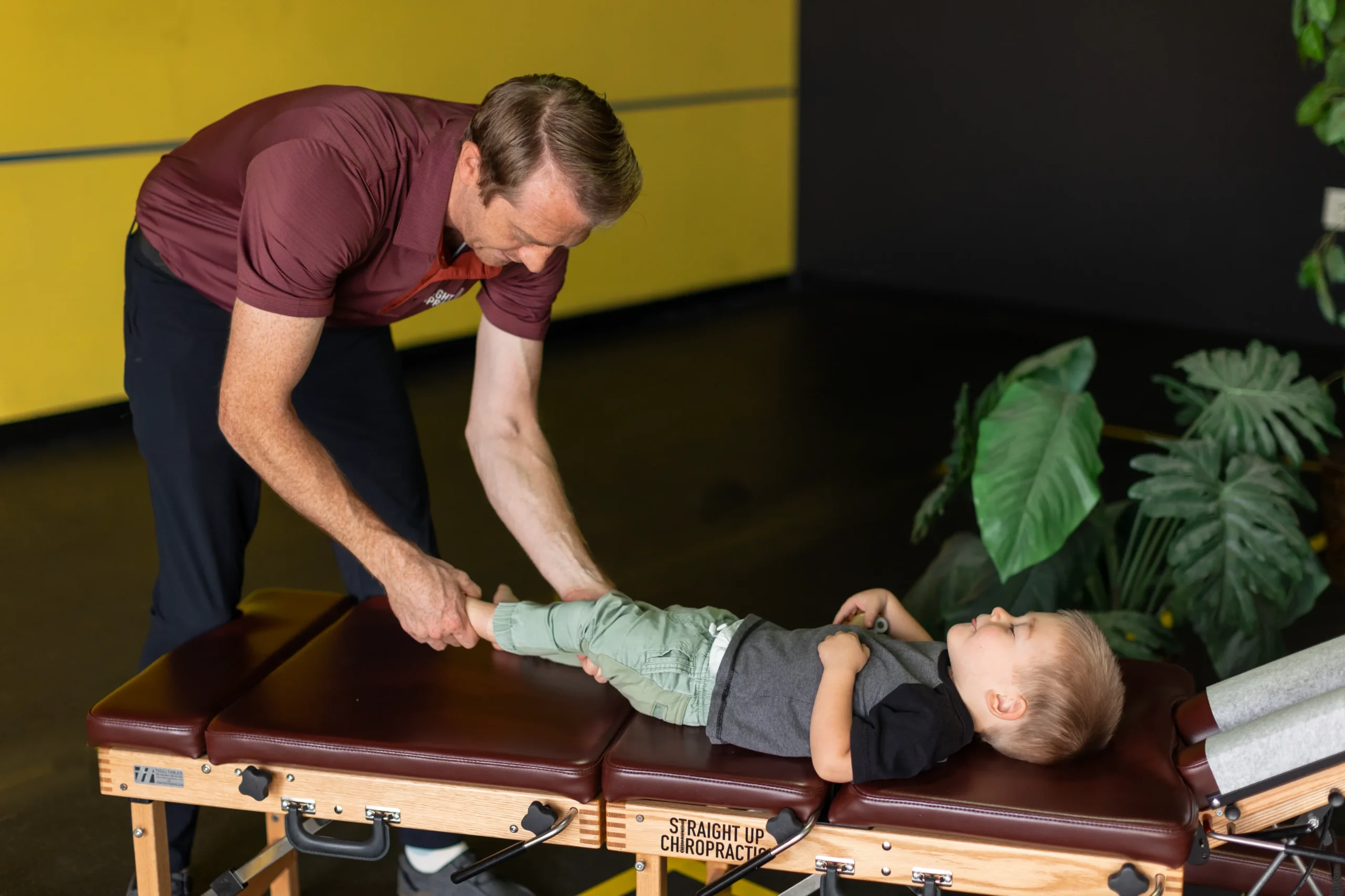
Expert Care for a Range of Conditions
At Straight Up Chiropractic, we offer specialized services designed to treat a variety of conditions that impact your daily life. Whether you’re dealing with chronic pain, recovering from an injury, or addressing specific health concerns, our personalized treatments are tailored to meet your unique needs. Dr. Gavin Hall uses advanced techniques such as A.M.I.T® and NPI to provide effective, long-lasting relief and help you achieve optimal health.
Nasal-Specific Cranial Adjustment
Our balloon cranial adjustment works to reset the cranial bones in the skull relieving pressure that can negatively affect the nervous system and reduce the flow of blood and cerebrospinal fluid throughout the brain.
Advanced Muscle Integration Technique (A.M.I.T®)
A.M.I.T® targets and corrects muscle and joint imbalances. This technique restores function, reduces pain, and improves performance, making it ideal for active individuals.
Targeted Spinal Adjustment
This adjustment realigns the six key regions of your spine to relieve pain and improve mobility. Dr. Hall ensures proper alignment, enhancing your overall spinal health.
Comprehensive Full Body Adjustment
Our Full Body Adjustment aligns all spinal regions and extremities, promoting optimal function and pain relief. It’s a complete approach to enhancing your body’s performance.
Neural Pathway Integration (NPI)
NPI corrects neurological inhibitions to restore connections between the brain and body. This gentle, non-invasive technique promotes proper neurological function.
Specialized Extremity Adjustment
This adjustment focuses on restoring function in the shoulders, elbows, wrists, hips, knees, and feet. It helps alleviate pain and improves joint mobility, keeping you active.
Targeted Treatments for Specific Conditions
Lower Back Pain
We treat both acute and chronic lower back pain, whether caused by poor posture, muscle strain, or injury. Our approach includes comprehensive spinal adjustments and specialized techniques like A.M.I.T® to provide relief and improve mobility.
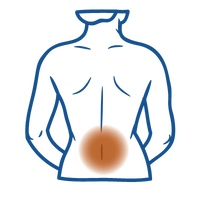
Sacroiliitis (SI Joint Syndrome)
Sacroiliitis is pain and inflammation of one or both of your sacroiliac joints located at the base of your spine where your lower spine and pelvis connect. Sacroiliitis can cause pain in your buttocks or lower back, and can extend down one or both legs. Pain may be worse with walking, weight-bearing, moving from sitting to standing, or flexing forward. It is often associated with ligament laxity or direct trauma.
Scoliosis
Scoliosis is a sideways curvature and/or rotary deformation of the spine occurring most often in teenagers during the growth spurt right before puberty. Most cases of scoliosis are mild and considered to have a genetic link. Scoliosis may be caused by birth defects, mesenchymal disorders, trauma, neoplasmic disease, or metabolic disease. Symptoms may include: uneven shoulders, one shoulder blade appearing more prominent than the other, uneven waist, or difficulty breathing.
Treatment options depend on the severity of the scoliosis. Mild scoliosis is best treated by conservative care: chiropractic adjustments, massage, exercise, yoga, good posture, etc. Moderate to severe forms of scoliosis may require bracing, or even surgical intervention.
If the symptoms are related to functional muscle inhibition, the A.M.I.T. ® method will allow the spine to balance out.
General Neck Pain
We address neck pain caused by trauma, poor posture, or stress. Our treatments focus on relieving pain, restoring mobility, and improving overall neck function.
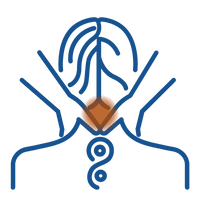
Cervical Dystonia (Spasmodic Wryneck or Torticollis)
Cervical dystonia is a painful condition in which the neck muscles contract involuntarily, causing the head to twist or turn to one side. This condition can also cause the head to uncontrollably tilt forward or backward. It can occur at any age and is more common in women than men. Babies can be born with this condition. Causes may include: certain reactions to drugs, trauma to the head, neck and upper shoulder injuries, or infections. Symptoms are characterized by the head and neck being locked in a rotated and flexed position with severe neck pain radiating into the shoulders. For some, the pain can be exhausting and disabling.
A.M.I.T. ® Explanation: The muscles of one side of the neck have been traumatized causing muscle inhibition and the joints to be inflamed. The body pulls the neck in a certain direction, which decreases the stress on the injured tissues, in an effort to protect them.
Cervical Sprain or Strain (Whiplash)
A condition in which the neck is suddenly hyperextended or hyperflexed such as the trauma associated with rear-end or head-on auto collisions. Pain may include: local or allover dull aching, local or allover sharp pain, swelling or weakness. Often the symptoms begin as sharp pain upon impact and evolve into a dull ache. Eventually after a few months, the patients may begin to develop arm, elbow or wrist pain, which does not respond to treatment.
A.M.I.T. ® Explanation: The muscles, discs, and joints in the neck are filled with complex nerve centers that assist in control of the head and neck. When these muscles and joints become injured or irritated, nerve centers cause the muscles of the neck to splint or tighten in an effort to protect from further injury. This situation leads to pain and restricted motion. The key is to normalize the joint and muscle function, which removes the source of the pain. This can occur rapidly using the A.M.I.T. ® methods.
Text Neck
Text neck is a term that has been coined to describe the posture formed by leaning forward or looking down for prolonged periods, for example when viewing a cellphone, reading, or texting. This stress over time often results in neck and shoulder pain, headaches, and thoracic hyperkyphosis (upper back hunch). Pain can be localized to one spot or may be diffused over an area, usually lower part of the neck. Can be described as dull aching or can also be sharp or stabbing in extreme cases.
Often times, a “simple fix” can be to lift your phone or book to your gaze, rather than dropping your head to look at your phone. Avoid excessive usage and take frequent breaks. Avoid slouching for prolonged periods of time.
Headaches
Our use of Neural Pathway Integration (NPI) quickly restores inhibitions causing headaches.
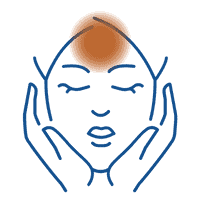
Cervicogenic Headache
A cervicogenic headache is caused by a problem in the neck. Causes may include multiple traumas to the neck, inflammation of the facet joints, or degenerative disease. Symptoms may include steady, non-throbbing pain at the back and base of the skull, a sensation of a tight band around the head, pain radiating up the neck into the skull, or neck stiffness.
A.M.I.T. ® Explanation: Any injury to the joints (facets) and muscles of the neck, which may cause joints to inflame and muscles to become inhibited or dysfunctional. Once damage has occurred, the body attempts to stabilize the neck by tightening the muscles supporting the head. This constant tension restricts circulation and lymphatic drainage leading to pain and inflammation.
Tension Headache
A tension headache is mild to moderate pain in the head; often a feeling like a tight band around the head is described. This is due to constant tightness of the muscles attached to the back of the head and into the neck and shoulders. Causes may include: neck trauma, constant emotional or physical stress, problems with teeth/jaw, or low-grade sinus inflammation triggers. Symptoms may include: dull, aching head pain, sensation of pressure across the forehead and back side of the head, or tenderness in scalp, neck, and shoulder muscles.
Migraine Headache
A migraine headache is throbbing or pulsing sensations in one area of the head. Early symptoms include aura and blurred vision occurring before or during migraine headaches. One may experience nervous system symptoms, flashes of light, sound and light sensitivity, nausea and vomiting, blurred vision, lightheadedness, fainting, speech problems, or vision loss. Attacks, untreated, may last from four to 72 hours.
Medically, the causes of migraine headaches are unknown and often involve many triggers.
Jaw Pain
Jaw pain is a relatively common issue that can be caused by a variety of factors, including dental problems, temporomandibular joint (TMJ) disorders, muscle tension, and more.
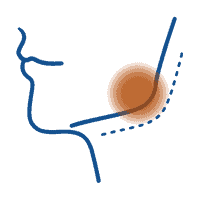
Temporomandibular Joint Disorder/Syndrome (TMJD)
TMJD is pain and tenderness due to dysfunction of one or both sides of the temporomandibular (jaw) joint or surrounding musculature and soft tissue. Symptoms include clicking, grinding, popping, locking, or catching of the joint with opening or closing the mouth. Often times there is also pain with chewing and can be the cause of headaches, earaches, or upper neck pain. The pain is almost always following a trauma to the face or side of the head: hit by a soccer ball in the face, car accident, concussion injury,
When the muscles of the jaw are traumatized, it causes them to become inhibited, The common muscles affected in TMJD are temporalis, masseter, pterygoid internal/medial, and pterygoid external/lateral. Functional imbalance of this musculature can cause the jaw joint to track improperly resulting in clicking, popping, discomfort, and pain. We have found the A.M.I.T. ® and NPI methods to be the most efficient way to correct this condition.
Shoulder Pain
Shoulder pain is a common issue that can be caused by a variety of factors, including injuries, overuse, medical conditions, and underlying health issues. The prevalence of shoulder pain can vary based on age, occupation, lifestyle, and other factors.
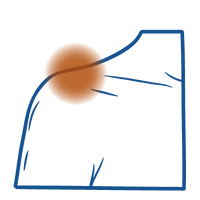
Rotator Cuff Strain/Syndrome
A rotator cuff is a group of muscles and tendons that surround the shoulder joint, stabilizing the head of the upper arm bone in the socket of the shoulder. Severe injuries may require surgical repair. Causes of rotator cuff injuries include sports injuries, lifting or pulling repetitive stress, or bone spurs.
A.M.I.T. ® Explanation: Rotator cuff syndrome is caused by an injury to one or more of the four shoulder muscles: Supraspinatus, Infraspinatus, Teres Minor, or Subscapularis (SITS) muscles. When these muscles are injured, their attachments, or entheses, become inflamed and cause pain any time the muscle is stressed. The A.M.I.T. ® method is the most efficient way to correct this condition. If a patient does not respond to therapy within two to three visits, the rotator cuff is torn requiring surgical repair.
Frozen Shoulder
Frozen shoulder is characterized by stiffness and pain in the shoulder joint. One may experience difficulty lifting the arm above 45 degrees. Causes may include: thickening of connective tissue making up the shoulder joint, tightening of connective tissue, flexion restriction of the head on the spine, injury to multiple shoulder support muscles, or damage to connective tissue. Patients may wake up one morning and find they cannot move their shoulder.
A.M.I.T. ® Explanation: This is a severe and chronically painful condition in which the patient is unable to move their shoulder and arm past 45 degrees. Our clinical research suggests this condition is caused by a number of factors. Muscle inhibition of the shoulder due to multiple injuries lead to a major functional imbalance, causing the muscles to become tight and painful when activated. The body restricts the motion to protect itself. Another common finding is extension and restriction in the motion of the base of the skull on the spine. This is caused when the small suboccipital muscles are inhibited due to upper neck trauma.
Shoulder Impingement
Shoulder Impingement is a common cause of shoulder pain. It occurs when there is impingement of tendons or bursa in the shoulder from bones of the shoulder. Causes of shoulder impingement may be any overhead activity of the shoulder, especially repeated activity.
A.M.I.T. ® Explanation: This is a severe and chronically painful condition in which the patient is unable to move their shoulder and arm past 90 degrees. It can last three months or longer and then completely go away. Some patients try surgery as a last resort yielding varying degrees of success. Our clinical research suggests this condition is caused by a number of factors. Muscle inhibition of the shoulder due to multiple injuries lead to a major functional imbalance, causing the muscles to become tight and painful when activated. The body restricts the motion to protect itself. These factors can be corrected using the A.M.I.T. ® methods.
Bicipital Tendonitis
Bicipital Tendonitis is an inflammation of one of the tendons that attach the muscle (biceps) on the front of the upper arm bone (humerus) to the shoulder joint. The inflammation is usually along the groove where the tendon passes over the humerus to attach above the shoulder. Causes may include overuse in throwing motions, inflammatory conditions, infections, or injury.
A.M.I.T. ® Explanation: The tendon of the long head of the biceps runs through a groove at the top part of the shoulder. A strong tissue holds this tendon in the grove, allowing for smooth gliding of the tendon when the arm is moved. This tendon may become inflamed leading to bicipital tendonitis; however, the primary cause of this condition is inhibition and inflammation of the attachments of muscles connecting close to this groove. The pectoralis major, latissimus dorsi, teres major, teres minor, subscapularis, and supraspinatus can all be involved. In addition, pain can also be coming from a referral from the cervical spine. Once the source of the pain is established, the condition can be correct using the A.M.I.T. ® method.
Elbow Pain
Elbow pain is also a common issue that can result from various causes, including overuse, injuries, medical conditions, and lifestyle factors. The prevalence of elbow pain can vary based on age, occupation, activities, and underlying health conditions.
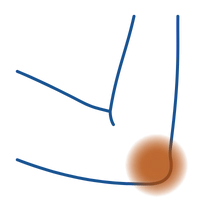
Lateral Epicondylitis (Tennis Elbow)
Tennis elbow is a painful condition occurring when repetitive motions of the wrist and arm overwork tendons in the elbow. Causes are due to overuse and muscle strain. Repeated motions and stress to the tissues may result in a series of tiny tears in the tendons attaching the forearm muscles to the outside of the elbow. Activities leading to causes may include golf, racket sports, throwing sports, weight lifting, or other wrist bearing activities. Pain associated may radiate from the outside of the elbow into the forearm and wrist. It may be difficult to shake hands, turn a doorknob, or hold a cup.
A.M.I.T. ® Explanation: Pain that occurs on the outside of the elbow is caused by inhibition of the wrist extensor muscles, inflammation of the periosteal tendon insertions (enthesis) of the extensor muscles or over development of the anterior shoulder muscles. Correction of this condition is accomplished by reactivating the extensor muscles and exercising the posterior shoulder muscles.
Medial Epicondylitis (Golfer’s Elbow)
Golfer’s elbow is similar to tennis elbow; instead the pain occurs on the inside of the elbow, where the tendons of the forearm muscles attach to the bony bump on the inside of the elbow. Causes are due to damage of the muscles and tendons controlling the wrist and fingers, usually related to excessive or repetitive stress. Activities leading to causes may include golf, racket sports, throwing sports, weight lifting, or other wrist bearing activities. Pain may include: tenderness on inner side of elbow, stiffness or pain making a fist, weakness in hands or wrists, or numbness and tingling into the ring and little fingers.
A.M.I.T. ® Explanation: Pain occurring on the inside of the elbow is caused by inhibition of the wrist flexor muscles, or over development of the anterior shoulder muscles. Correction of this condition is accomplished by reactivating the flexor muscles and exercising the posterior shoulder muscles.
Wrist Pain
Wrist pain is a common issue that can be caused by a variety of factors, including overuse, injuries, medical conditions, and repetitive motions. The prevalence of wrist pain can vary based on age, occupation, activities, and underlying health conditions.
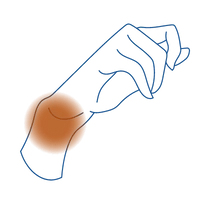
Wrist Sprain
Wrist sprains can be caused by sudden injuries. Causes of sprains or strains may vary. Pain may include dull aching or various degrees of pain and tenderness.
A.M.I.T. ® Explanation: Damage to any of the muscles that cross the wrist, or to any of the ligaments that support the wrist, can lead to pain. Jamming of the carpal bones by a fall landing on the extended wrist and hand is the most common cause. Manipulating the bones back into proper alignment creates immediate relief.
Carpal Tunnel Syndrome
Carpal Tunnel Syndrome is a progressively painful hand and arm condition caused by a nerve pinched in the wrist. Carpal tunnel syndrome is caused by compression of the median nerve. The median nerve runs from the forearm, through a passageway in the wrist (carpal tunnel) to the hand. Anything that crowds irritates or compresses the median nerve can lead to pain. Pain may include tingling or numbness in fingers and hand, pain radiating or extending from the wrist to the arm and shoulder, or down into palm and fingers, or a sense of weakness in hands.
A.M.I.T. ® Explanation: This condition is caused by falling on the hands, jamming the bones in the wrist, repetitive stress, or trauma to the wrist. This leads to compression of the median nerve by the retinaculum supporting the wrist or the inhibition of the pronator quadrates muscle. The symptom may also be due to irritation of nerve roots in the cervical spine. Manipulating the cervical spine or carpal bones can cause a dramatic change in symptoms without surgery. Correction is achieved by manipulating the bones back into alignment or reactivating the pronator quadrates muscle taking the pressure off the nerve.
Wrist or Thumb Tenosynovitis
De Quervain’s Tenosynovitis is a painful condition that affects the two tendons located on the thumb side of the wrist. De Quervain’s Tenosynovitis may be caused by repeated movement leading to the tendon sheath becoming inflamed and thickened. Pain may include: pain in wrist, pain at base of thumb, swelling near base of thumb, or difficulty grasping or pinching.
A.M.I.T. ® Explanation: This condition may be caused by multiple traumas to the thumb leading to joint fixation and muscle inhibition. It can be corrected by reactivating the muscles and manipulation of the thumb.
Hip & Thigh Pain
Hip and thigh pain can be caused by a variety of factors, ranging from overuse and muscle strains to medical conditions and injuries. The prevalence of hip and thigh pain can vary based on age, lifestyle, and underlying health conditions.
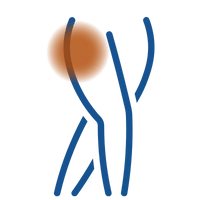
Piriformis Syndrome
Piriformis Syndrome is an uncommon neuromuscular disorder. The piriformis muscle is a flat, band-like muscle located in the buttocks near the top of the hip joint. It stabilizes the hip joint, lifting and rotating the thigh away from the body. Piriformis syndrome is caused when the piriformis muscle compresses the sciatic nerve.
Pain may include tingling, or numbness in the buttocks, pain extending down the leg, sciatica after sitting for long periods of time, pain walking, or running. Most cases of sciatica are not due to piriformis syndrome.
A.M.I.T. ® Explanation: The piriformis muscle attaches to the greater trochanter and fans out to attach to the lateral side of the sacrum. When this muscle becomes chronically tight, it can cause pressure on the sciatic nerve, leading to symptoms associated with sciatica. In a small percentage of patients, the sciatic nerve runs through the piriformis muscle, instead of under it. Inhibition of this muscle is the most common cause of irritation, which is easily corrected using the A.M.I.T. ® method. Another common cause is sitting on a wallet for extended periods of time.
Hip Bursitis
Hip Bursitis is a painful condition affecting the small fluid-filled pads, called bursae, which act as cushions along with bones, tendons, and muscles near the joints. Bursitis occurs when bursae become inflamed. Causes of hip bursitis are repetitive motions or positions that irritate the bursae around a joint. Pain may include: feeling achy or stiff, pain with movement or pressure, or an area appearing swollen and red.
A.M.I.T. ® Explanation: Inflammation of the bursa in the area of the hips. There are multiple bursa in the hip such as Ischial-Gulteal Bursa, Trochanteric Bursa, and Iliopsoas Bursae. The primary causes of pain are muscles attached to the hip that are injured or inhibited. Forcing injured or inhibited muscles to work may create pain and reduced motion, increasing degenerative changes.
Hip Sprain/Strain
Hip sprains and strains are common injuries sharing similar signs and symptoms. A sprain is a stretching or tearing of ligaments, the tough bands of fibrous tissue connecting bones in the joints. Causes may include: falling, a direct blow to the muscle (a contusion), overstretching, or overuse causing muscle fibers to tear. Pain may include pain over the injured muscle, swelling, or loss of strength and mobility in the muscle.
A.M.I.T. ® Explanation: When the hip is traumatized, muscles may become overloaded and inhibit to protect from more serious injury. Inhibited muscles do not contract in appropriate ways. From that point on, any time the muscle is loaded it “gives way” in a weak response. If it continues to be stressed, the pain will result in an effort to protect the muscle from more injury. The body will not allow motion it cannot stabilize, resulting in motion restriction for that plane of motion. Stretching the muscles to increase motion may only set up conditions for more severe injuries.
Knee Pain
Knee pain is a common issue that can arise from various causes, including injuries, overuse, medical conditions, and underlying health factors. The prevalence of knee pain can vary based on age, activity level, lifestyle, and other factors.
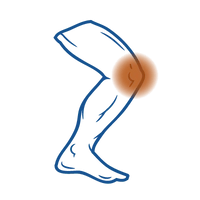
Patellar Tendonitis (Jumper’s Knee or Osgood Schlatter Disease)
Patellar Tendonitis is an injury affecting the tendon connecting the kneecap (patella) to the shinbone (tibia). The patellar tendon helps the muscles extend the knee to kick a ball, run uphill, and jump up in the air. Causes may include: overuse, repeated stress on the patellar tendon creating tiny tears in the tendon. When tears become numerous they cause pain from inflammation and a weakening of the tendon structure.
A.M.I.T. ® Explanation: This condition is caused by muscular imbalances of the quadriceps complex, gluteus maximus muscle group, and the gastrocnemius muscles. Each of these muscles has its own precise action. When these muscles become inhibited due to injury or overuse, their tendonous attachments become inflamed during the first six weeks following injury. After six weeks have lapsed, degenerative processes begin. The pain centers in the tendon/bone attachment, called the enthesis, generating intense pain to unload the muscle and protect it from tearing. Due to the muscle’s inability to stabilize the kneecap, it does not track properly and the condylar surface becomes inflamed and more prone to degenerative changes.
Chondromalacia Patella (Patellofemoral Pain Syndrome)
Chondromalacia Patella is a term indicating damage to the cartilage under the kneecap. It is characterized by softening of the cartilage surfaces. Causes may include overuse or repetitive stress on the knee joint, poor control of the muscles, when muscles around the hip and knee don’t function optimally to maintain proper tracking of the kneecap, or trauma to kneecaps, such as a dislocation or fracture.
A.M.I.T. ® Explanation: When muscles supporting the knee joint become inhibited from the accumulation of injuries, they no longer support the joint. The stress of weight-bearing is increased on the cartilage and other connective tissues. This creates a chronic inflammatory and degenerative process. If there is the addition of long-standing nutritional deficiencies related to cartilage repair, the cartilage surfaces begin to soften and degenerative processes are increased. Frequent consumption of soda pop can increase joint degeneration as well.
Ankle, Foot & Leg Pain
Ankle, leg, or foot pain can be caused by a variety of factors, ranging from injuries and overuse to medical conditions and underlying health issues. The prevalence of pain in these areas can vary based on age, activity level, lifestyle, and other factors.
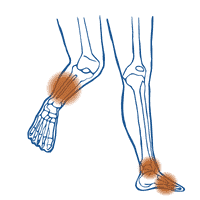
Ankle Sprain
An ankle sprain occurs when one rolls, twists, or turns the ankle in an awkward way. This can stretch or tear the tough bands of tissue (ligaments) that help hold the anklebones together. Ligaments help stabilize joints, preventing excessive movement.
A.M.I.T. ® Explanation: During an inversion sprain, the lateral stabilizing ligaments are stretched and sustain a certain degree of tearing. Additionally, the peroneus muscles are injured and inhibited. Once these muscles are inhibited, the ankle loses its control, causing instability and future ankle sprains.
Achilles Tendonitis
Achilles Tendinitis is an overuse injury of the Achilles tendon, the band of tissue connecting the calf muscles at the back of the lower leg to the heel bone. Causes may include an intense or repetitive strain of the Achilles Tendon.
A.M.I.T. ® Explanation: Irritation and inflammation of the Achilles tendon, which is made up of the medial and lateral gastrocnemius and soleus muscles, resulting in pain 1-2 inches above calcaneus/heel. When muscles are overloaded due to multiple factors, they become inhibited and cannot contract efficiently leading to an overuse condition and pain. If muscles are not activated, the tendinous attachments begin to break down and eventually rupture.
Shin Splints
Shin splints refer to pain along or just behind the shinbone (tibia). Causes may include excessive force (overload) on the shinbone and connective tissue that attach the muscles to bone, running downhill, running on a slanted or tilted surface, running in worn-out footwear, engaging in sports with frequent start and stops, or physical training errors.
A.M.I.T. ® Explanation: Shin splints are a complex problem found in many athletic activities, more commonly seen in patients who display over-pronation of the foot and ankle. Shin splints are divided into two types: anterior and posterior shin splints. The cause of each occurs when the muscle attaching into these areas become inhibited. These include tibialis anterior, tibialis posterior, flexor hallucis longus, extensor hallucis longus, and extensor digitorum longus. These muscles attach to either the periosteum of the bone or the interosseous membrane. When any of these muscles become inhibited and stressed through athletic activities, they become inflamed and lose their ability to contract and relax under changing conditions, leading to pain at the attachment. In addition, the muscles cannot control concentric/eccentric control of the arch of the foot, allowing over-pronation to occur. This contributes to increased torque on the interosseous membrane.
Plantar Fasciitis
Plantar Fasciitis is inflammation of a thick band of tissue, called the Plantar Fascia, which runs across the bottom of the foot and connects the heel bone to the toes. Plantar Fasciitis is one of the most common causes of heel pain. Causes of Plantar Fasciitis are due to small tears in the fascia. Under normal circumstances, the Plantar Fascia acts like a shock-absorbing bowstring that supports the arch in the foot. If tension on the bowstring becomes too great, it begins to tear.
A.M.I.T. ® Explanation: The cause of this condition is inhibition of the primary arch support muscles (tibialis anterior, tibialis posterior) of the foot. This leads to overstressing of the small flexor muscles of the toes and the plantar aponeurosis. Failure of the supporting muscles allows the foot to over-pronate, adding to the problem. This places all the stress of supporting the arch on the plantar aponeurosis and causes inflammation and break down.
Neurological Disorders

Concussions
Dizziness and vertigo are sensations that can disrupt balance, making a person feel unsteady or as if they are moving. Dizziness is a broad term for feelings of lightheadedness, wooziness, or disorientation and can be triggered by various factors, such as dehydration, a sudden drop in blood pressure, or standing up quickly. Vertigo, a specific type of dizziness, creates a spinning or moving sensation, even though there is no actual movement. This can be accompanied by nausea, vomiting, sweating, or difficulty walking.
Vertigo is a symptom rather than a condition and can arise suddenly or persist over time, often due to inner ear issues like benign paroxysmal positional vertigo (BPPV), migraines, or vestibular neuritis. Our Neural Pathway Integration (NPI) Technique offers relief from dizziness and vertigo by targeting and resetting the brain centers involved in these sensations, often leading to significant symptom improvement or complete resolution.
Vertigo/Dizziness
Trigeminal neuralgia (TN), also known as tic douloureux, is a chronic pain condition that causes sudden, intense facial pain described as electric shock-like, stabbing, or burning sensations on one or both sides of the face. This pain can be triggered by everyday facial movements, such as talking, eating, or brushing teeth, and may also occur spontaneously at rest. TN is thought to be caused by a blood vessel pressing on the trigeminal nerve, though it can also result from tumors, multiple sclerosis, or other conditions.
Our Neural Pathway Integration (NPI) Technique offers targeted relief for TN by stimulating and resetting specific brain centers that regulate these pain responses, often resulting in substantial symptom improvement or complete relief.
Trigeminal Neuralgia
Shin splints refer to pain along or just behind the shinbone (tibia). Causes may include excessive force (overload) on the shinbone and connective tissue that attach the muscles to bone, running downhill, running on a slanted or tilted surface, running in worn-out footwear, engaging in sports with frequent start and stops, or physical training errors.
A.M.I.T. ® Explanation: Shin splints are a complex problem found in many athletic activities, more commonly seen in patients who display over-pronation of the foot and ankle. Shin splints are divided into two types: anterior and posterior shin splints. The cause of each occurs when the muscle attaching into these areas become inhibited. These include tibialis anterior, tibialis posterior, flexor hallucis longus, extensor hallucis longus, and extensor digitorum longus. These muscles attach to either the periosteum of the bone or the interosseous membrane. When any of these muscles become inhibited and stressed through athletic activities, they become inflamed and lose their ability to contract and relax under changing conditions, leading to pain at the attachment. In addition, the muscles cannot control concentric/eccentric control of the arch of the foot, allowing over-pronation to occur. This contributes to increased torque on the interosseous membrane.
Concentration
Difficulty concentrating can stem from various causes, including sleep deprivation, traumatic brain injuries, stress, poor diet, medication side effects, mental health conditions, thyroid issues, autoimmune disorders, or diabetes, among others. Our Neural Pathway Integration (NPI) Technique is designed to address concentration difficulties by stimulating and resetting the brain structures involved in focus and mental clarity.
This targeted approach often results in significant improvement or even complete resolution of concentration challenges, helping individuals regain focus and productivity.
Hyperemesis Gravidarum
Hyperemesis Gravidarum (HG) is a severe pregnancy complication marked by extreme, persistent nausea and vomiting. It can result in dehydration, weight loss, and electrolyte imbalances, affecting approximately 2% of pregnancies in the United States, with no known cure. Our Neural Pathway Integration (NPI) Technique is designed to alleviate HG symptoms by stimulating and resetting specific brain centers responsible for these abnormal sensations. This targeted approach often leads to significant symptom improvement or complete relief, helping expectant mothers regain comfort and well-being during pregnancy.
Digestive Health Support

Digestive Health
Digestive issues, such as bloating, constipation, acid reflux, and irregularity, can greatly impact daily life and overall well-being. These problems may be influenced by stress, diet, lifestyle, or underlying health conditions. Our Neural Pathway Integration (NPI) Technique is designed to address digestive discomfort by promoting better communication between the nervous system and the digestive organs. Through gentle stimulation and resetting of neural pathways, NPI helps restore balanced digestive function, often reducing or eliminating symptoms for lasting relief.
Take the Next Step Toward Relief
Don’t let pain or discomfort hold you back any longer. At Straight Up Chiropractic, we’re here to help you find lasting relief from a wide range of conditions. Whether you’re struggling with chronic pain, recovering from an injury, or dealing with specific health concerns, our advanced chiropractic techniques can make a difference. Let us guide you on your journey to better health and well-being.
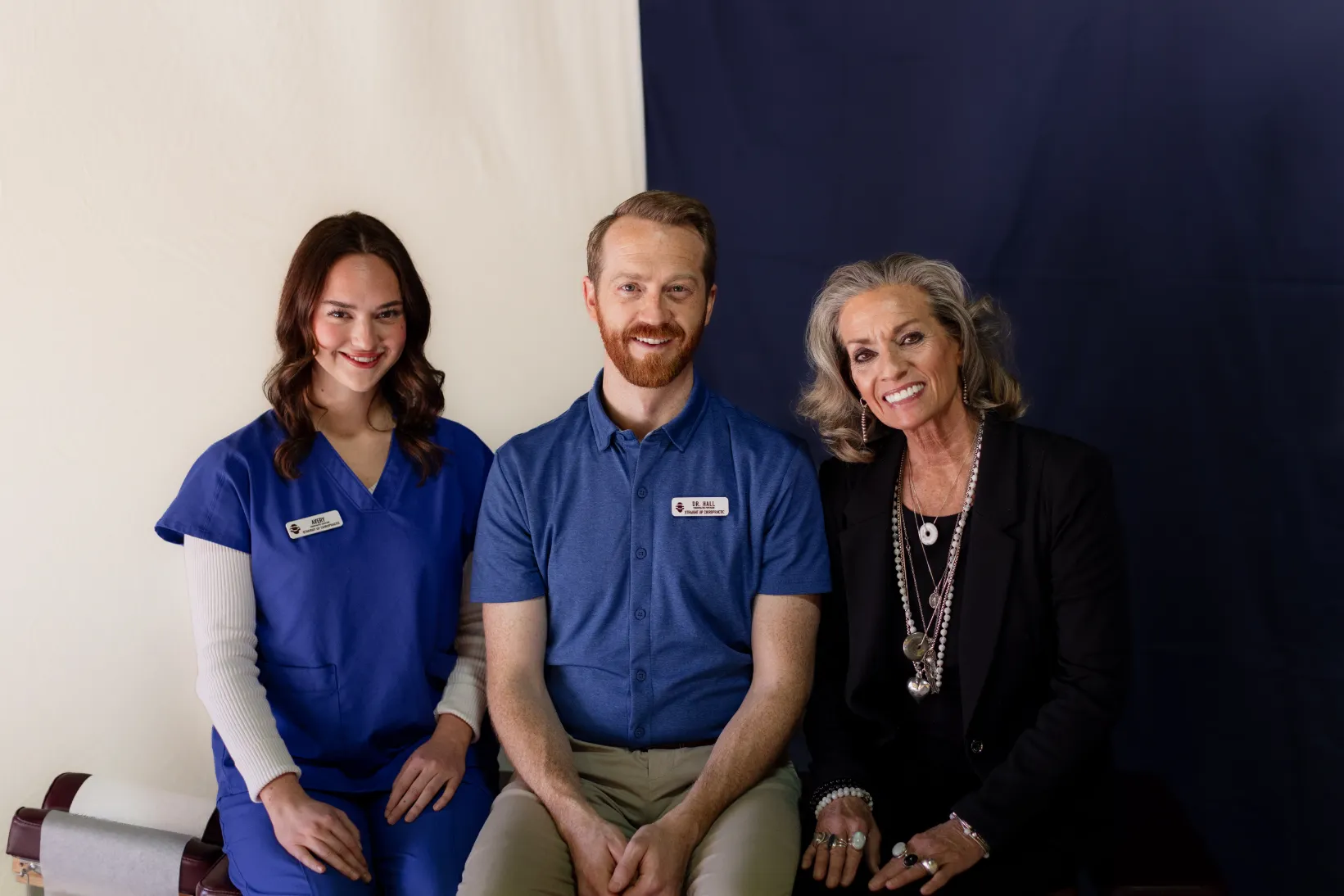
Frequently Asked Questions
What is the importance of the toggle/atlas adjustment?
Aligning the first and second bones in the neck is a toggle adjustment. Aligning those neck bones can improve nervous system function. Your brain stem runs through the middle of these two bones. When the neck bones are out of alignment, it can create pressure on the brain stem. Setting these neck bones back in place can reset the nervous system.
How do patients know how many muscles are shut down?
After your first appointment with the doctor, the doctor will review the results of your exam. This will outline specific muscle groups that are not firing. After discussing your treatment plan with the doctor, you will be recommended to set up a series of appointments to get you on the road to balance and wellness.
Is it normal for pain to move or change?
Yes. As muscles are reactivated and begin to contract properly across a joint, there is new stability. As new stability enters the joint, pain often moves or shifts to different areas that are not yet stable and need more muscles activated.
What causes a muscle to shut down?
It may be surprising to know that there are many things that can contribute to muscle imbalances. The 3 most common causes of muscle inhibition are direct trauma to the muscle, overstretch of the muscle, and overuse of the muscle.
What is the average number of muscles a patient has that are shut down?
The body has over seven hundred muscle systems. Every patient is unique and individual. We see patients with as little as 10-15 muscles shut down and others have 70 or more that are shut down. Our goal is to get you balanced and able to achieve your goals. We want to help you live pain-free and resume your active life.
How does a muscle become activated?
To activate a muscle, our doctors and therapists use a technique by applying pressure to the attachments of the injured muscle. This involves stimulating key reflex points. The doctor stimulates these points to get the muscles to re-fire. This takes the load off the muscles that are in pain and often tight. When the therapy is done, the doctor will reassess the injured muscle for strength to ensure it is reactivated. If there is strength, the muscle has been effectively restored and the pain is minimized or gone.
How often do I need to schedule treatments and how many muscles should I schedule each time?
The treatment process is individual. The patient and the doctor determine a treatment plan based on the report of findings. At each appointment, the doctor or therapist will discuss how much of the prescribed treatment has been done. The units of therapy take approximately five minutes. We are able to do a maximum of six units of therapy per session. After the full treatment the patient will move to a maintenance plan. This is a check up appointment every six to eight weeks which helps prevent future injuries.
Does a muscle ever need to be activated twice?
A muscle needs to be activated again only if it gets reinjured. Occasionally, the doctor will find a muscle that has already been treated that didn’t hold. If this occurs, the doctor will look at an organ, gland, nerve, or brain structure in the body associated with that muscle’s weakness and treat it (via NPI). The doctor will retest the muscle, which will be strong again.
To feel pain-free does every muscle need to be activated?
Pain is the body’s natural alarm system. This tells us which areas need attention and care. Our A.M.I.T.® treatment addresses these alarms to provide stability and strength. Through treatment, we can increase range of motion and function. During the process of treatment, you may notice that pain in one area lessens and another area feels worse. This guides us to the muscle area that needs attention and we find the next muscle group that is unstable. By balancing muscles, we can help you get to a pain-free life. Each unit of therapy should provide some relief. The pain won’t often go away in the first treatment. Not all the muscles need to be reactivated for pain to ease up. You may be pain-free and still have muscles that need to be treated. It is important to follow the treatment plan so no further injuries happen.
Which order are muscles activated?
At each visit, the doctor will find the areas of instability and treat those areas. Each person is individual and the body will lead us to which muscle needs treatment next. Each person has individual accidents and injuries. This makes it impossible to have a one-size-fits-all in the muscle treatment process.
Why is the doctor working nowhere near the area of pain?
The body often gets injured in layers. The body remembers injuries that accumulate with time over the many big or small injuries we acquire throughout life. Each time an injury occurs, if muscles cannot properly stabilize the joint, compensation occurs throughout the muscles of the body to try to create stabilization. Because of compensations, muscle injuries that occur in one area can lead to pain somewhere else and must be treated in that reversed order – peeling off layers of old injuries in order to treat the new one.
Should I schedule regular visits?
Patients on wellness care schedule regular A.M.I.T. appointments to correct instabilities that arise. A good schedule is every 4-8 weeks. These appointments are essential for maintaining optimal muscle health and preventing future injuries. This is important to be able to continue to enjoy a pain-free, active lifestyle. However, Dr. Hall will advise on treatment that helps you enjoy a pain-free life at what is affordable for you. Most patients continue care to provide optimal performance for an active lifestyle.
Do you take insurance?
No, to help keep costs of chiropractic care down, Straight Up Chiropractic does not take insurance. Instead, our online system automatically emails each patient a Super Bill that contains all you need to submit to your insurance, and receive reimbursement.
What can I expect on my first visit?
The first visit to our office includes a lot of talking. We want to understand what you are experiencing. In many cases, this health assessment may involve testing by moving the joints or muscles that are injured. The chiropractor may test how you sit, stand, move, bend or stretch based on your pain tolerance and the issues you came in for. Oftentimes the first visit will include a description of why you may be experiencing the pain or symptom, a plan of action, and even treatment, as time permits.
What does a chiropractor treat?
Over 70% of our patients come to us because they want healing with their back and neck. We provide immediate relief as well as long term healing with our expertise and experience. Other areas of high need that we help include hips, knees, and hamstrings/quads. Some other examples of what we treat are below.
Back pain
Sciatica
Arthritis
Auto injuries
Neck pain
Sports injuries
Chronic pain and fatigue
Low or lack of energy
Digestive problems
Sprained Ankles
Concussions
Headaches
Joint pain
Rotator cuff strains
Tendonitis
Carpal tunnel
Tennis elbow
Golfers elbow
Bursitis
IT Band syndrome
Piriformis syndrome
Patellar tendonitis
Osgood Schlatters
Sever’s disease
Shin splints
Achilles tendonitis
Plantar fasciitis
